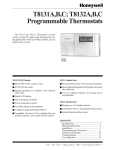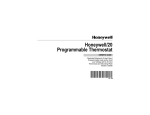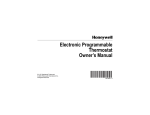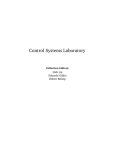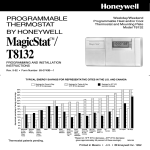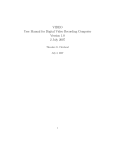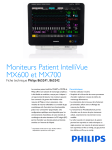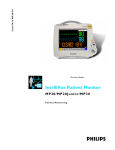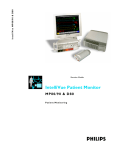Download Honeywell D User's Manual
Transcript
T8112C,D Electronic Programmable Thermostats INSTALLATION INSTRUCTIONS Location APPLICATION The T8112C,D thermostats provide electronic programmable control for 24 to 30 Vac heating and cooling systems. RECYCLING NOTICE If this control is replacing a control that contains mercury in a sealed tube, do not place your old control in the trash. Contact your local waste management authority for instructions regarding recycling and the proper disposal of the old thermostat. INSTALLATION Install the thermostat about 5 ft. (1.5m) above the floor in an area with good air circulation at average temperature. Do not install the thermostat where it can be affected by: — drafts, or dead spots behind doors and in corners. — hot or cold air from ducts. — radiant heat from sun or appliances. — concealed pipes and chimneys. — unheated (uncooled) areas such as an outside wall behind the thermostat. Mounting Plate Installation Position mounting plate on the wall. Use a level to make sure mounting plate is level. Use a pencil to mark the two mounting holes. See Fig. 1. WALL ANCHORS (2) When Installing this Product… WIRES THROUGH WALL OPENING 1. Read these instructions carefully. Failure to follow them could cause a hazardous condition. 2. Check the ratings given in the instructions and on the product to make sure the product is suitable for your application. 3. Installer must be a trained experienced service technician. 4. After installation is complete, check out product operation as provided in these instructions. WALL MOUNTING PLATE CAUTION MOUNTING SCREWS (2) 1. Disconnect power supply to prevent electrical shock or equipment damage. 2. After wiring is complete, push excess wire back into the hole and plug hole with nonhardening caulk, putty or insulation to prevent drafts from affecting thermostat operation. ®U.S. Registered Trademark Copyright © 1998 Honeywell Inc. • • All Rights Reserved M1718 Fig. 1. Mounting plate installation. X-XX UL 69-0917-2 T8112C,D ELECTRONIC PROGRAMMABLE THERMOSTATS IMPORTANT When using a high efficiency furnace such as a 90 percent or greater AFUE (Average Fuel Utilization Efficiency) unit, adjust screw A out one turn and screw B in. 1. Remove mounting plate from the wall, and drill 3/16 inch holes in wall (if drywall) as marked. For firmer material such as plaster or wood, drill 7/32 inch holes. Gently tap anchors (provided) into drilled holes until flush with the wall. 2. Reposition mounting plate over holes, pulling wires through wiring opening. Loosely insert two mounting screws into holes. THERMOSTAT BACK 3. Level for appearance only; the thermostat will function properly even when not level. Tighten mounting screws. See Fig. 2. A C B D W FOR HIGH EFFICIENCY FURNACE (90%+ AFUE) ADJUST: SCREW A–OUT 1 TURN SCREW B–IN FUEL SWITCH – F POSITION LEVEL ADJUST SCREWS THROUGH HOLES TO SELECT OPERATION DESIRED FUEL SWITCH HEATING SYSTEM POSITION WARM AIR B–IN A–IN F FURNACE HOT WATER A–OUT B–IN F 1 TURN BOILER ELECTRIC B–OUT E A–IN FURNACE 1 TURN FUEL SWITCH E F Y G Rc R M3669 Fig. 3. Back view of thermostat. Wiring Thermostat All wiring must comply with local electrical codes and ordinances. Refer to Fig. 4 through 7 for typical hookups. A letter code is located near each terminal for identification. See Table 1 for terminal cross referencing information. M1714A Fig. 2. Leveling mounting plate. Adjust Fan Operation Switch, as Required CAUTION Disconnect power before wiring to prevent electrical shock or equipment damage. The Thermostat fan operation switch, labeled FUEL SWITCH is factory set in the F position. See Fig. 4. This is the correct setting for most systems. If your system is an electric heat system, set the switch to E. The E setting allows the fan to turn on immediately with the heating or cooling in a system where the G terminal is connected. 1. Connect the system wires to the thermostat. See Fig. 8. A letter code is located near each terminal for identification. NOTE: Hold the thermostat as shown in Fig. 9 to minimize need for wire extenders. Adjust System On-time, as Required The system on-time is factory-set for a warm air, gas or oil heating system. If you are installing it on another type of system, the system on-time must be adjusted accordingly by setting screws A and B on the back of the thermostat. Use the heating system table shown in Fig. 3 as a guide. The system on-time should be optimized according to the type of system to minimize room temperature swings. Setting the screw out one turn means turning the screw approximately 360° or one complete turn. Setting the screw in means tightening the screw completely down. 2. Securely tighten each terminal screw. 3. Push excess wire back into the hole. 4. Plug hole with nonflammable insulation to prevent drafts from affecting the thermostat. Table 1. Typical Wire Colors and Functions In the event that you want longer furnace on-time, readjust the screws A and B as follows: • Warm Air Furnace—set at the Hot Water setting (A— out one turn, B—in). • Electric Furnace—Leave at the Warm Air Furnace setting (A—in, B—in). Connect to Wire Colora G Green Fan Y Yellow Cooling Function W White Heating Rc Blue Air Cond. Power R Red Furnace Power a Wire colors are typical; verify at heating/cooling equipment connection. NOTE: This thermostat does not have a setting for steam/gravity air. Cycles would not be long enough for accurate temperature control. 69-0917—2 Thermostat Terminal 2 T8112C,D ELECTRONIC PROGRAMMABLE THERMOSTATS 5-WIRE HEAT/COOL (JUMPER REMOVED) 2-WIRE HEAT-ONLY (JUMPER INTACT) A C A C B D B D W Y JUMPER G W Rc R HEATING RELAY OR VALVE COIL Rc FAN RELAY 1 L2 1 G R HEATING RELAY OR VALVE COIL L1 (HOT) Y POWER SUPPLY. PROVIDE DISCONNECT MEANS AND OVERLOAD PROTECTION AS REQUIRED. COOLING CONTACTOR COIL 1 1 L1 (HOT) M1709B L1 (HOT) L2 Fig. 4. Typical hookup in two wire lead only (jumper intact) application. C B D POWER SUPPLY. PROVIDE DISCONNECT MEANS AND OVERLOAD PROTECTION AS REQUIRED. M1711B Fig. 6. Typical hookup in five wire heat and cool (jumper removed) application. 4-WIRE HEAT/COOL (JUMPER INTACT) A L2 1 3-WIRE COOL-ONLY (JUMPER INTACT) W Y G JUMPER R A C B D Rc W Y G JUMPER HEATING RELAY OR VALVE COIL COOLING CONTACTOR COIL R FAN RELAY COOLING CONTACTOR COIL L1 (HOT) L2 1 Rc FAN RELAY POWER SUPPLY. PROVIDE DISCONNECT MEANS AND OVERLOAD PROTECTION AS REQUIRED. M1710B L1 (HOT) L2 Fig. 5. Typical hookup in four wire heat and cool (jumper intact) application. 1 POWER SUPPLY. PROVIDE DISCONNECT MEANS AND OVERLOAD PROTECTION AS REQUIRED. M848A Fig. 7. Typical hookup in three wire cool only (jumper intact) application. 3 69-0917—2 T8112C,D ELECTRONIC PROGRAMMABLE THERMOSTATS T8112C JUMPER (FACTORYINSTALLED) REMOVE IF 5-WIRE SYSTEM A. ENGAGE TABS AT TOP OF THERMOSTAT AND MOUNTING PLATE. B. PRESS LOWER EDGE OF CASE TO LATCH. Rc R 5/16 in. (8 mm) STRIP INSERT STRAIGHT UNDER SCREW HEAD AM TU LEAVE W Y G END OF WIRE VISIBLE HERE M1712A Fig. 8. Proper wiring technique. M5780 T8112D A. ENGAGE TABS AT TOP OF THERMOSTAT AND MOUNTING PLATE. B. PRESS LOWER EDGE OF CASE TO LATCH. M3002A Fig. 9. Holding thermostat while installing. C. Mounting Thermostat on Mounting Plate SWING COVER OPEN TO CHECK OPERATION. 1. Engage tabs at the top of thermostat and mounting plate. See Fig. 10. 2. Press lower edge of case to latch. NOTE: To remove the thermostat from the wall, first pull out at the bottom of the thermostat; remove top last. M13063 Fig. 10. Mounting thermostat on mounting plate. 69-0917—2 4 T8112C,D ELECTRONIC PROGRAMMABLE THERMOSTATS As the batteries are running low, a “bAt Lo” indicator flash for one to two months before batteries run out completely. Replace the batteries as soon as possible after the indicator starts flashing. If the batteries are not replaced sometime during the flashing “bAt Lo,” the indicator eventually stops flashing. “bAt Lo” will stay on without flashing, indicating the thermostat and heating/cooling system have stopped working and the batteries are almost completely dead. Installing Batteries IMPORTANT Batteries must be installed for programming and operation of the thermostat and heating/cooling system. 1. Use two AA alkaline batteries; nonalkaline batteries will not last as long, and can leak, causing damage to the thermostat or wall surface. Energizer batteries are recommended. After the batteries are completely dead, the “bAt Lo” indicator disappears, leaving a completely blank display. 2. Make sure the thermostat is set in the OFF position. To remove, press down on left ends of batteries. If the new batteries are installed within 20 to 30 seconds of removing the old ones, the thermostat does not have to be reprogrammed. If the display is blank, the batteries are dead or incorrectly installed and the thermostat has to be reprogrammed. See Owner’s Manual for programming instructions. 3. Use a coin to remove the battery door. See Fig. 11. 4. Install the new batteries making sure positive and negative terminals are oriented correctly. See Fig. 12. 5. Replace battery door. SETTINGS Current Time/Day To set time, press and release the Set Clock/Day key once. Press the Time keys until the current time shows. To set day, press and release the Set Clock/Day key again. Press the Time keys until the current day shows. Press Run Program key. See Owner’s Manual for complete programming instructions. M5781 Fan Switch FAN AUTO: Normal setting for most homes. A singlespeed fan turns on automatically with the air conditioner of furnace. A two-speed fan usually runs on high with the air conditioner and on low with the furnace. Fig. 11. Removing battery door. INSTALL TWO AA ALKALINE BATTERIES AS SHOWN NOTE: When Fan Operation Switch on the back of the thermostat is in E position, the fan operates with the furnace only. AM TU LEAVE FAN ON: The fan runs continuously. Used for improved air circulation during special occasions or for more efficient electronic air cleaning. Fan Auto On System System Switch Cool Off Heat FAN SWITCH System switching positions control thermostat operation as follows: COOL: The thermostat controls the air conditioning system. OFF: Both the heating and air conditioning systems are off. HEAT: The thermostat controls the heating system. SYSTEM SWITCH M5782 Fig. 12. Installing batteries. 5 69-0917—2 T8112C,D ELECTRONIC PROGRAMMABLE THERMOSTATS CHECKOUT Fan Heating Move the thermostat system switch to OFF and the fan switch to ON. The fan should run continuously. With the system switch still in the OFF position, move the fan switch to AUTO; the fan should stop. Do not check heating system operation by jumpering thermostat terminals at the primary control such as the gas valve, zone valve, or oil burner control This will damage the thermostat. Instead, you could jumper R and R wires at the thermostat. Move the system switch to HEAT and the fan switch to AUTO. Press key until the setting is about 10°F (6°C) above room temperature. Heating should start and the fan should run after a short delay (immediately if fan operation switch is set in E position). Cooling To avoid possible compressor damage, do not operate the cooling system when outside temperature is below 50°F (10°C). See compressor manufacturer instructions for further information. Press key until setting is about 10°F (6°C) below room temperature. The heating equipment should shut off. NOTE: When cooling setting is changed, thermostat can delay up to five minutes before turning on the air conditioner. This delay protects the compressor. Move the system switch to COOL and the fan switch to AUTO. Press key until setting is about 10°F (6°C) below room temperature. The cooling equipment and fan should start. Press key until the setting is about 10°F (6°C) above room temperature. The cooling equipment and fan should stop. Move the system switch to OFF and the fan switch to AUTO. The system and fan should be off. 69-0917—2 6 T8112C,D ELECTRONIC PROGRAMMABLE THERMOSTATS TROUBLESHOOTING GUIDE If… Then… Display will not come on. • Set the system switch to OFF. Remove batteries. Insert batteries backward for at least five seconds to reset thermostat. Correctly replace batteries. Display should come on. • Make sure batteries are fresh and installed correctly. • Gently clean battery contacts using a soft pencil eraser. Do not use anything abrasive on the clips. Temperature display will not go lower than 45° F (7° C) or higher than 88° F (31° C) during programming. • The temperature setting limit is reached. The setting range is 45° F to 88° F (7° C to 31°C). Temperature change occurs at the wrong times. • Check the program times for the period in question. Be sure that AM and PM indications are correct. Make sure the current day and time are correct. Reprogram if necessary. Heating will not come on. • Check that switch on thermostat is set to HEAT. Allow a minimum of five minutes for time guard protection to expire. • Check the system fuse or circuit breaker and replace or reset if necessary. • Check for correct wiring and good connections. • Disconnect and jumper wires R and W. If heat does not come on, check out the heating system. • If display is blank or says “bAt Lo,” install fresh batteries. Cooling will not come on. • Check that switch on thermostat is set to COOL. Allow a minimum of five minutes for time guard protection to expire. • Check the system fuse or circuit breaker and replace or reset if necessary. • Check for correct wiring and good connections. • Disconnect and jumper wires R and Y. If cooling does not come on, check out the cooling system. • If display is blank or says “bAt Lo,” install fresh batteries. • The thermostat has a built-in time delay on cooling. Allow at least five minutes after changing the setting before the air conditioner starts. • Make sure outdoor disconnect is engaged (on). • If temperature setting is lower than current temperature, and SYSTEM ON indicator is lit, move system switch from COOL to OFF for ten minutes. After ten minutes, return switch to COOL position. If air conditioner comes on, compressor could have reached its high limit temperature protection and shut down. • If 2- or 4-wire installation, verify that R-Rc jumper is installed Too warm or too cool. • Press Run Program key to check the current temperature setting. • If desired, change the temperature setting. See the Owner’s Manual. SYSTEM ON indicator is lit, but no heat is coming from the registers. • Allow time for the furnace to heat up and the fan to come on before checking for heat at the register. (Check to make sure the Cycle Rate in the Installation section is correct.) Thermostat current temperature setting does not match the display temperature to within ± 1°. • Check that the wiring hole in the wall behind the wallplate has been plugged with insulation to prevent drafts that might adversely affect thermostat operation. • Be aware that it is normal for the current setting and display temperature to differ on occasion. • During recovery from setback or setup, setting and display temperatures can differ for up to 30 minutes after recovery period. bAtLo remains on display after batteries are installed. Remove batteries. Wait one hour. Install fresh Alkaline batteries. NOTICE This equipment is a Class B digital apparatus, which complies with Canadian Radio Interference Regulations, CRC c.1374. 7 69-0917—2 T8112C,D ELECTRONIC PROGRAMMABLE THERMOSTATS Home and Building Control Honeywell Inc. Honeywell Plaza P.O. Box 524 Minneapolis, MN 55408-0524 69-0917—2 G.H. Rev. 4-98 Home and Building Control Honeywell Limited-Honeywell Limitée 155 Gordon Baker Road North York, Ontario M2H 3N7 Printed in Mexico 8 www.honeywell.com









